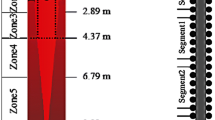Abstract
This paper focuses on hot tearing in continuous casting of steel and the experimental as well as numerical prediction of the hot tearing susceptibility. As a preliminary point, the current understanding of the appearance of this kind of defects and the resultant requirements for numerical und experimental hot tearing simulation will be briefly summarized. The next section describes the experimental determination of critical strain values by means of the proven SSCT (Submerged Split Chill Tensile) test and their implementation into a 1D-FV-solidification model (one-dimensional-finite-volume) developed in-house. Exemplarily, the model will be applied to the casting of two medium carbon steel grades on a slab casting machine.
Zusammenfassung
Die vorliegende Veröffentlichung beleuchtet einleitend das heutige Verständnis des Erscheinungsbildes und des Bildungsmechanismus von Heißrissen im Stranggießprozess. Daraus werden die Forderungen an die numerische und experimentelle Simulation dieser häufig auftretenden Fehlerform abgeleitet. Der experimentelle Teil beschreibt die Ermittlung von kritischen Dehnungen im SSCT–Test (Submerged-Split-Chill-Tensile) und die Umsetzung dieser Kennwerte in ein 1D-FV-Erstarrungsmodell (Eindimensionales-Finite-Volumen). Abschließend wird das Modell auf das Beispiel des Vergießens zweier mittelkohliger Stähle auf einer Brammenstranggießanlage angewendet.






Similar content being viewed by others
References
Pierer, R.; Bernhard, C.; Chimani, C.: A contribution to hot tearing in the continuous casting process, Revue de Metallurgie-CIT, 2 (2007), pp 72–83
Bernhard, C.; Pierer, R.: A new hot tearing criterion for the continuous casting process, Proceedings of the 5th Decennial International Conference on Solification Processing, Sheffield, UK, 2007, pp 525–530
Bernhard, C.; Pierer, R.: The nature of internal defects in continuously cast steel and their impact on final product quality, Iron and Steel Technology Conference Proceedings, Pittsburgh, PA, USA, 2010, pp 193–203
Wagnieres, J. D.; Ackermann, P.: Le laboratoire d’aujourd’hui pour les brames de demain, La Revue Polytechnique, 6 (1985), no. 1464, 669–673
Xia, G.: Untersuchungen über das mechanische Verhalten von erstarrendem Stahl unter stranggußähnlichen Bedingungen, Doctoral Thesis, Leoben, Montanuniv., Chair of?, 1992
Bernhard, C., Mechanische Eigenschaften und Rißanfälligkeit erstarrender Stähle unter stranggießähnlichen Bedingungen, Doctoral Thesis, Leoben, Montanuniv., 1998
Zirngast, J.: Zugversuche an direkt aus der Schmelze erstarrten Stahlschalen mit einem Erstarrungssimulator, Doctoral Thesis, Leoben, Montanuniv., 1993
Hiebler, H.; J. Zirngast, J.; Bernhard, C.; Wolf, M.: Inner crack formation in continuous casting: stress or strain criterion?, Proceedings of the 77th Steelmaking Conference, Chicago, USA, 1994, pp 583–593
Bernhard, C.; Hiebler, H.: Mechanical properties of solidifying steels under continuous casting conditions, Proceedings of the 7th International Continuous Casting Conference, Linz, 1996, 7/1–7/7
Bernhard, C.; H. Hiebler, H.; Wolf, M.: The Influence of Phosphorus on the Mechanical Properties of Carbon Steels near the Melting Point at Low Strain Rate, Conference Proceedings of the Belton Memorial Symposium, Sydney, Australia, 2000, pp 263–272
Ilie, S.; Reiter, J.; Presslinger, H.; Fluch, J.; Bernhard, C.: Characterization of hot tear segregations in continuous casting of slabs, Proceedings of the 6th European Continuous Casting Conference, Riccione, Italy, 2008, Paper 122
Bernhard, C.; Pierer, R.; Tubikanec, A.; Chimani, C.: Experimental simulation of defect formation in the continuous casting process, SMEA Conference and Exhibition, University of Sheffield, UK, 2007, Session II, Paper 2
Ackermann, P., Kurz, W.; Heinemann, W.: In situ tensile testing of solidifying Aluminium and Al–Mg shells, Materials Science and Engineering 75 (1985), no. 1–2, pp 79–86
Bernhard, C.; Hiebler, H.; Wolf, M.: Simulation of Shell Strength Properties by the SSCT Test, ISIJ International, 36 (1996), Supplement, pp 163–166
Hiebler, H.; Bernhard, C.: Mechanical properties and crack susceptibility of steel during solidification, Steel Research, 70 (1999), no. 8–9, pp 349–355
Bechet, S.; Beaujard, L.: Nouveau reactif pour la mise en évidence micrographique du grain austénitique des aciers trempés ou trempés-revenus, Revue de Metallurgie, 92 (1995), no. 10, pp 923–929
Reiter, J.; Pierer, R.; Illie, S.; Preßlinger, H.; Fluch, J.; Bernhard, C.: Über die Bildung von Heißrissseigerungen in Stahl: Vergleichende Untersuchungen an Stranggussbrammen und Laborversuchsproben, BHM (Berg- und Hüttenmännische Montanhefte), 155 (2010), Nr. 3, 129–135
Michelic, S. K.; Hartl, M.; Bernhard, C.: Thermodynamic and Experimental Study on the Modification of Nonmetallic Inclusions Through the Contact with CaO-Al2O3-MgO Slags, AISTech 2011 Proceedings, Volume II (2011), pp 617–626
Bernhard, C.: A transient 2.5D-Solidification Model at the interface between laboratory experiment and the continuous casting process, The 7th International Conference on Physical and Numerical Simulation of Materials Processing, Oulu, Finnland, 2013
The AISE Steel Foundation (Ed.): The Making, Shaping, and Treating of Steel: Casting volume 11th edition, The AISE Steel Foundation, Pittsburgh, PA., 2003
Hadler, M.: Bestimmung der kritischen Dehnung der Heißrissbildung in Abhängigkeit der Erstarrungsstruktur mit Hilfe von Einwalzversuchen und Laborexperimenten, Master thesis, Leoben, Montanuniv., Chair of Ferrous Metallurgy, 2010.
Rauter, W.: Über die Bedeutung der Erstarrungsstruktur in Hinblick auf die Heißrissbildung beim Stranggießen von Vorblöcken, Hot Cracking Workshop, Technische Universität Graz, 14th Dec. 2010
Acknowledgements
Financial support by the Austrian Federal Government (in particular by the Bundesministerium für Verkehr, Innovation und Technologie and Bundesministerium für Wissenschaft, Forschung und Wirtschaft) represented by Österreichische Forschungsförderungsgesellschaft mbH and the Styrian and the Tyrolean Provincial Governments, represented by Steirische Wirtschaftsförderungsgesellschaft mbH and Standortagentur Tirol, within the framework of the COMET Funding Programme is gratefully acknowledged.
Author information
Authors and Affiliations
Corresponding author
Rights and permissions
About this article
Cite this article
Arth, G., Ilie, S., Pierer, R. et al. Experimental and Numerical Investigations on Hot Tearing during Continuous Casting of Steel. Berg Huettenmaenn Monatsh 160, 103–108 (2015). https://doi.org/10.1007/s00501-015-0345-6
Received:
Accepted:
Published:
Issue Date:
DOI: https://doi.org/10.1007/s00501-015-0345-6




